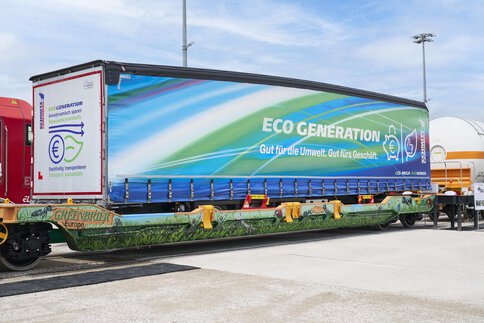More traffic: transport logistic connects players for competitive and climate-friendly rail freight transport
According to a study published by the German government in October 2024, transport volumes are expected to increase significantly—from 689 to 905 billion tonne-kilometres by 2040. Rail freight transport, especially combined transport, is projected to play a greater role and must therefore become more competitive.
Forecasts signal traffic growth
The German Federal Ministry predicts a 35% increase in rail freight transport, despite recent volume declines caused by the energy transition and the war in Ukraine. At transport logistic 2025, industry and political representatives discussed how the sector can address this growth via climate-friendly rail, even with limited resources.
Rail protects the climate—but must become more competitive
Shifting transport to rail is a key lever for climate protection. To make this work, services must become easier to integrate, and processes more digital. Shared platforms and standardized interfaces should ensure smooth information flow and improve collaboration across transport chains. The industry plans to invest in transparency and competitiveness, especially in managing the complexity of combined transport, giving rail an edge over road as a green alternative.


transport logistic proves to be a hub for integrated solutions
Every two years, Messe München becomes the networking hub of the logistics industry—especially appreciated by rail freight professionals. The broad cross-sector setup of the trade fair brings together all stakeholders: from shippers to receivers, as visitors, speakers or exhibitors. Key exhibitors concentrate in the 'Freight Transport Equipment' section and the well-attended outdoor area. Start-ups, SMEs and major players value transport logistic for its high-calibre conference program, where science, politics and industry meet on rail freight.
A recognized hot spot for rail freight transport
In Munich, international manufacturers, service providers, infrastructure operators and customers come together to seek solutions for competitive rail freight. Exhibits include locomotives, freight wagons and accessories from major players like Alstom, Siemens, and Stadler. Railway companies from around the world—from SBB to Rail Cargo Group to Beijing Trans Eurasia—are present. Especially in combined transport, exhibitors interact across transport modes with service providers, technology developers and operators.


Digitalization transforms collaboration in rail freight
The shared goal: faster, more reliable rail freight handling, even with limited resources. As complexity grows, transparency is key. For sound decisions, all parties need access to information—beyond company boundaries. The industry is working to break down proprietary data silos. At transport logistic 2025, artificial intelligence, open systems and unified interfaces were highlighted as game-changers—but also as cybercrime entry points. This is especially critical for infrastructure like rail stations, ports and airports. Despite progress, there's still digital potential to unlock rail’s full competitiveness.
Combined transport becomes simpler—and more relevant
The modal shift to rail is a powerful climate strategy and driver for combined transport. In Munich, freight forwarders, operators, rail companies, terminals and many more came together. Across all halls and transport modes, combined transport was a top topic. Rail featured in various combinations with road, sea, and air. Exhibitors presented complex intermodal and multimodal solutions involving equipment providers, service firms, consultants, tech partners and operators—with a common goal: uninterrupted, reliable transport chains.
The trade fair builds trust and networks for rail
The complexity of rail freight still intimidates many road-focused shippers and forwarders. Combined transport's many players can be off-putting. Aging infrastructure, delays and capacity bottlenecks fuel scepticism. Every two years, transport logistic makes a strong case for rail, showcasing the performance of systems and providers across global logistics chains. Exhibitors and speakers present their latest innovations and research. Forum sessions focus on both processes and logistics hubs, showing how modern and efficient goods handling can be—especially in ports and hinterland terminals.
Combined transport well represented
Long distances make combined transport an international business. Many relevant exhibitors came from abroad—including China, Kazakhstan and the UAE. At transport logistic 2025, around 150 companies exhibited in this segment. These included freight forwarders, operators, rail companies, infrastructure providers and others in the combined transport value chain. High-level experts discussed what combined transport can deliver, what conditions must be met and what role it will play in the future. As part of climate efforts, the shift to rail—especially via combined transport—remains essential. Leading companies like Kombiverkehr, Hupac and Eurogate, along with first- and last-mile providers, were on-site and have already committed to transport logistic 2027.
Rail is better than its reputation—and still underestimated
Confidence in rail performance is rising, but challenges remain. Construction sites hinder traffic flow. To prevent persistent bottlenecks, corridors are being upgraded, tracks and connections reactivated. At the same time, pressure is rising from climate demands, costs and staff shortages. The event’s curated conference program tackled these issues over three days, highlighting what's needed politically, socially and economically for rail to succeed. Despite obstacles, the industry remains optimistic. Its future lies in rail freight—especially in combined transport with strong intermodal links.
Innovation is moving more freight to rail
Roads are full of trucks. Although about 90% of trailers are non-craneable, modal shift is still possible. transport logistic showcases how technology is breaking existing paradigms. Exhibitors and partners—including VDV, Fraunhofer IML, LKZ Prien and key media—engaged with major players like DB Cargo, Mosolf, TX Logistik, Lkw Walter, Rail Cargo Group, Amazon Transportation Services and Kombiverkehr. They explored innovations and new approaches from all perspectives. One thing is clear: shifting freight to rail must become easier. The industry is investing in capacity and competitiveness. At transport logistic, experts from academia, business and government exchange ideas and showcase innovations in 64 conference slots, exhibitor insights and on the Campus Plaza. Rail freight is front and centre—and with growing volumes, it will take on an even larger role at the next event.
